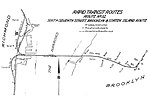65th Street Yard

The 65th Street Yard, also Bay Ridge Rail Yard, is a rail yard on the Upper New York Bay in Sunset Park and Bay Ridge, Brooklyn. Equipped with two transfer bridges which allow rail cars to be loaded and unloaded onto car floats, the last of once extensive car float operations in the Port of New York and New Jersey. Located adjacent to the Brooklyn Army Terminal, it provided a major link in the city's rail freight network in the first half of the twentieth century. It was later used as a conventional railroad yard at the end of the LIRR/NY&A Bay Ridge Branch. The new transfer bridges were constructed in 1999, but remained unused until the transfer bridges were activated in July 2012.
Excerpt from the Wikipedia article 65th Street Yard (License: CC BY-SA 3.0, Authors, Images).65th Street Yard
Belt Parkway, New York Brooklyn
Geographical coordinates (GPS) Address Nearby Places Show on map
Geographical coordinates (GPS)
| Latitude | Longitude |
|---|---|
| N 40.64224 ° | E -74.02955 ° |
Address
65th Street Yard
Belt Parkway
11209 New York, Brooklyn
New York, United States
Open on Google Maps









